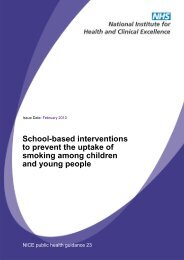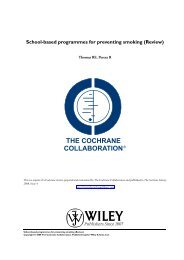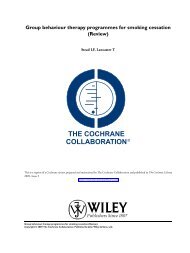Smoking and mental health - NCSCT
Smoking and mental health - NCSCT
Smoking and mental health - NCSCT
You also want an ePaper? Increase the reach of your titles
YUMPU automatically turns print PDFs into web optimized ePapers that Google loves.
<strong>Smoking</strong> among people with <strong>mental</strong> disorders 2<br />
60<br />
<strong>Smoking</strong> prevalence (%)<br />
45<br />
30<br />
15<br />
1993<br />
1994<br />
1995<br />
1996<br />
1997<br />
1998<br />
1999<br />
2000<br />
2001<br />
Year<br />
Patients with a longst<strong>and</strong>ing <strong>mental</strong> <strong>health</strong> condition<br />
Patients with no longst<strong>and</strong>ing <strong>mental</strong> <strong>health</strong> condition<br />
2002<br />
2003<br />
2004<br />
2005<br />
2006<br />
2007<br />
2008<br />
2009<br />
2010<br />
Fig 2.1 Changes in smoking prevalence between 1993 <strong>and</strong> 2010 in<br />
participants with or without longst<strong>and</strong>ing <strong>mental</strong> <strong>health</strong> conditions (with<br />
95% confidence intervals (CIs); data from the Health Survey for Engl<strong>and</strong><br />
(HSE)).<br />
were smokers. Of the 11% of adults in Engl<strong>and</strong> estimated by APMS to have<br />
consulted a GP in the past year for a <strong>mental</strong>, nervous or emotional complaint,<br />
33% were smokers, of the 3% of adults who had received counselling for a<br />
<strong>mental</strong>, nervous or emotional complaint at the time of the survey, 35% were<br />
smokers, <strong>and</strong> of the 0.7% of adults who had made one or more suicide attempts<br />
in the last year, 57% were smokers.<br />
2.3.3 THIN<br />
Data from the THIN primary care database add further confirmation of the high<br />
prevalence of smoking among those with diagnosed <strong>mental</strong> disorders <strong>and</strong> those<br />
taking psychoactive medications (Table 2.4). Although there is inevitable<br />
inconsistency between the proportions in disease-specific diagnostic groups <strong>and</strong><br />
those using related medications (eg those with diagnosed depression <strong>and</strong> those<br />
taking antidepressants), which probably reflects both a failure to regularly update<br />
diagnostic recording <strong>and</strong> the use of psychoactive drugs for other indications (see<br />
section 2.2.3), smoking prevalence in all the groups in Table 2.3 is substantially<br />
<strong>and</strong> statistically significantly higher than in the population without these<br />
morbidities or prescription drug use.<br />
© Royal College of Physicians 2013 23














